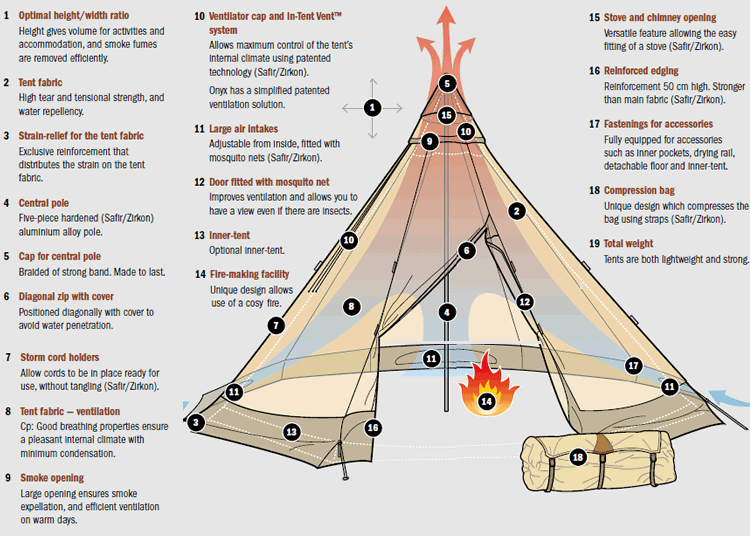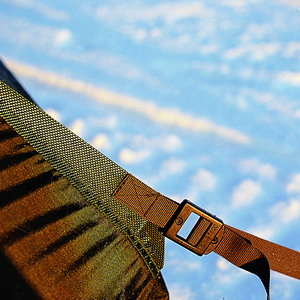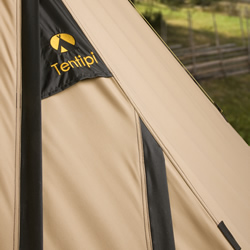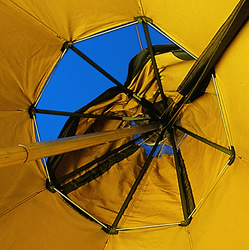The perfect tent fabric would be weightless, let all condensation pass through, be completely waterproof and super-strong. Of course, such a fabric will never be made. Different tent manufacturers use many different tent fabrics. Often the fabrics look alike when they are new, but the differences are quite substantial. A poor quality tent will let you down just when you need it the most. Tent fabrics intended for all-year-round usage must meet up to rigorous demands.

Cotpolmex P
Light, highly breathable and really strong 50/50 cotton/polyester fabric, creating a much better internal atmosphere than normally experienced in tents. The tightly woven fabric and high class impregnation gives high water repellency. The light tan color creates a pleasing warm-colored atmosphere. Cotpolymex P is similar to Cotpolmex C, but with better shape stability and improved aesthetic appeal. To our knowledge, the absolute finest cotton/polyester tent fabric available globally.

Cotpolmex C

Traillix P

Traillix C

Traillix B
Lightweight ripstop nylon 6 fabric, PU-coated on one side. Carefully selected to be waterproof after prolonged use. The fabric is grey and non breathable.

Superpolyamide pine green

Inner-tent fabric light

Floor fabric 120 g
The sun’s UV-rays
Our coated fabrics are UV-stabilized. Our cp fabrics are a 50/50 cotton-polyester blend which is considerably more resistant to sunlight compared with similar types of cotton fabrics. Even so, do not expose the fabric to sunlight unnecessarily since cotton and most types of nylon (even if UV-stabilized) are eventually weakened by the sun’s ultraviolet light.
Tearing
Everyone knows how easy it is to punch a hole in a paper bag, and how easily the hole extends once it’s made. The same thing happens with low quality tent fabrics. Quality fabrics however, must not tear further even in the event of a rip. We have four different ways of solving this problem.
1. The impregnated cp fabrics have a 50 percent polyester mix which substantially strengthens the fabric.
2. A silicone coating increases the strength of the fabric 2–3 times compared with other coated fabrics.
3. Our very lightest fabrics are constructed using a ripstop technique. This means that reinforcement threads are woven into the fabric in a chequered pattern. Any tears or holes are stopped by these reinforcement threads but without making the fabric too heavy.
4. The fiber's material and quality play an important role. Less expensive cotton fabrics use short fibers which give poor strength. We use fabrics with longer cotton fibers. For the coated fabric used for the Safir light, we have chosen high-tenacity polyamide. This type of nylon has a different molecule structure, which makes the fibers more than twice as strong as ordinary nylon.
Tear strength varies greatly between the tents available on the market. In fact, it is quite common for some manufacturers to use fabrics that have only 1/6 of the tear strength of our most advanced fabrics!
Rain
There are two ways of making a fabric waterproof.
1. The fabric is impregnated with an agent that increases surface tension which in turn prevents water droplets from penetrating the fabric.
2. The fabric is given a coating which is completely waterproof. The quality of this treatment is measured in how well the coating binds with the fabric’s fibers. Even really cheap fabrics can be relatively waterproof when new but after being used for a time, the difference becomes apparent.
Condensation
Impregnated fabrics breathe and let out condensation straight through the fabric. Coated fabrics do not.
If you want to buy a Nordic tipi of lightweight material and without an inner-tent, you will manage quite well in some circumstances. For instance, in the forest where the wind won’t shake the fabric, condensation will run easily down the fabric to the ground due to the slanted construction. Normally, condensation is not a problem in dry weather either. However, we always recommend using the inner-tent.
Summary
Considering the complex nature of the practical and weather requirements placed on a tent, we have chosen fabrics that best meet these various requirements and needs.
Fabric guarantee
Guarantee against material faults in accordance with current legislation in each respective country. Guaranteed water-resistant for 12 months. However, please note that an impregnated, non-coated fabric is not guaranteed to resist rain in combination with a strong wind because then the water droplets hit the fabric with such a high speed that they sometimes overcome the impregnation’s water resistance.
Guarantee does not apply for damage arising through accidents, incorrect care or careless handling. Normal wear and tear or damage caused by the sun’s ultraviolet radiation is not covered by the guarantee.
 Loading... Please wait...
Loading... Please wait...



 Read our article:
Read our article: 











